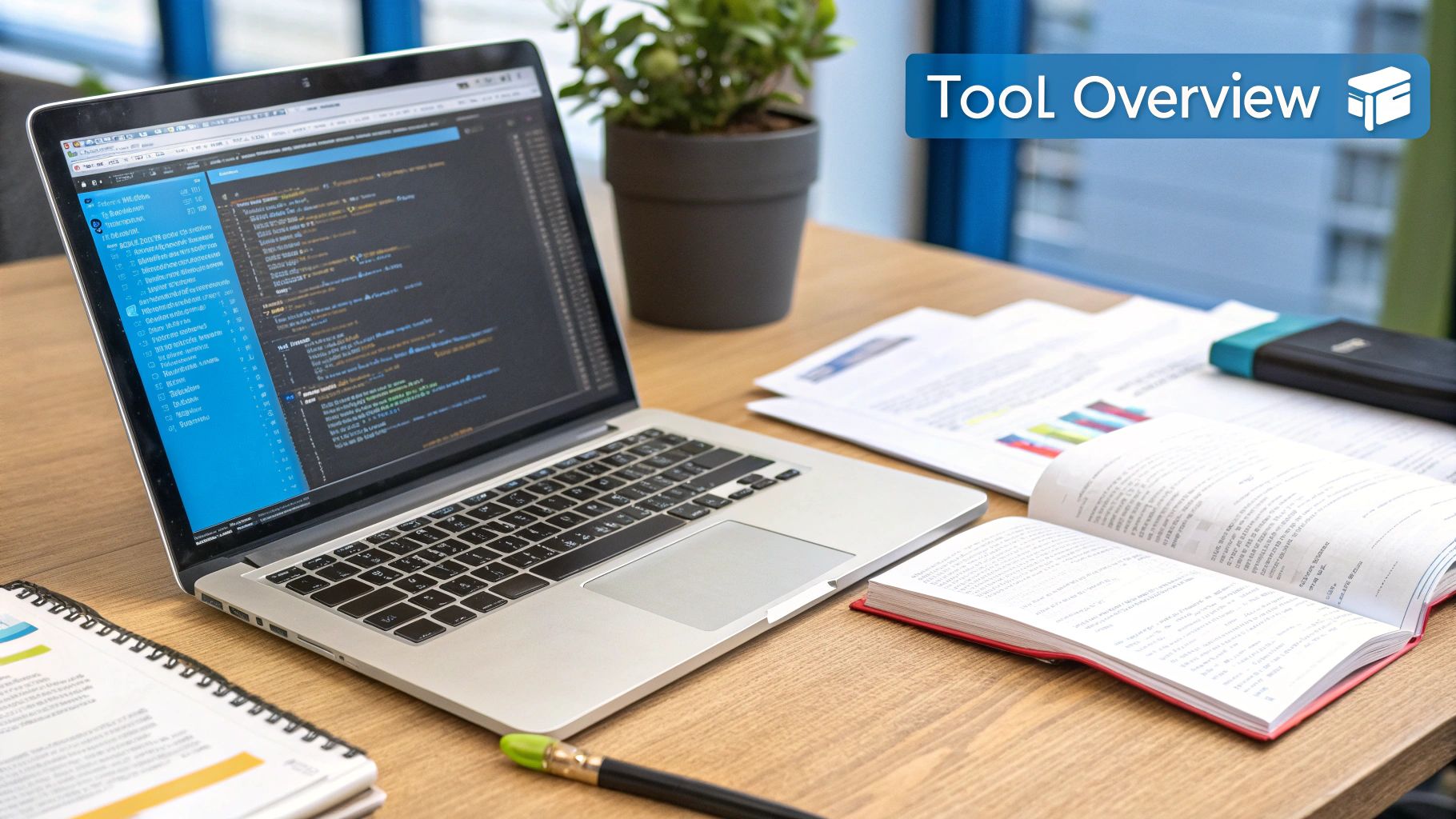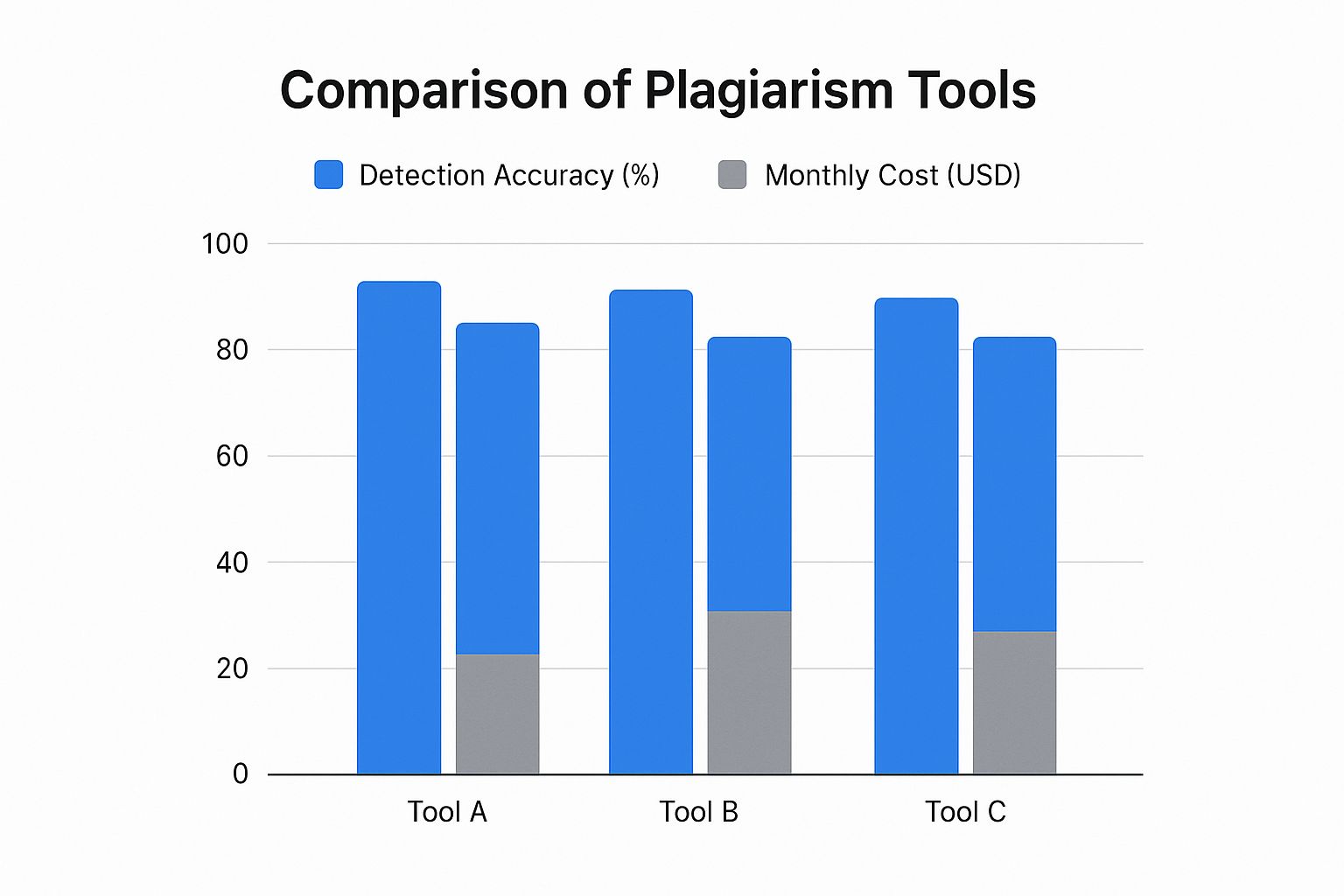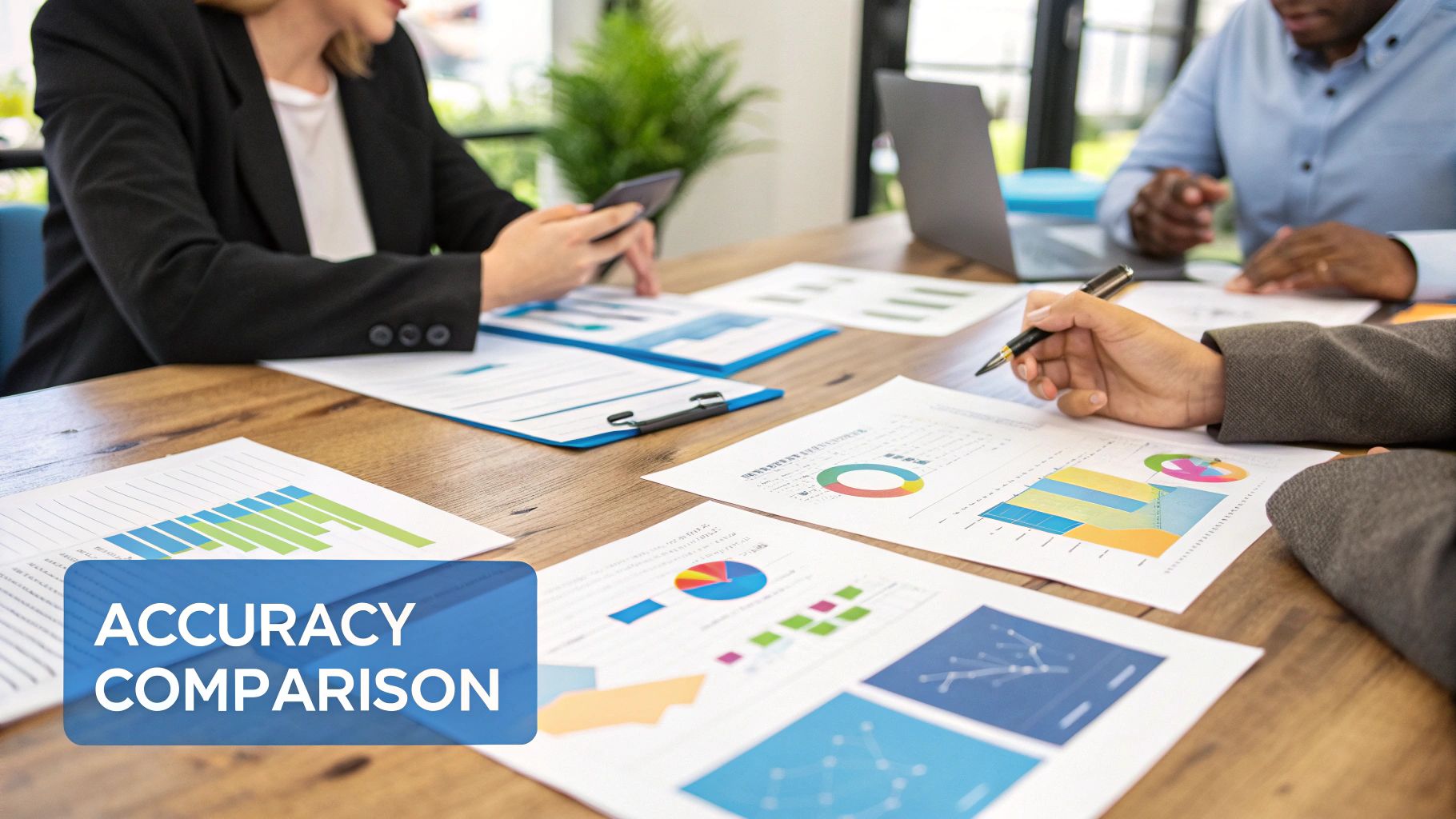Understanding The Modern Plagiarism Detection Landscape
The methods for ensuring academic and content integrity have advanced significantly beyond catching simple copy-and-paste actions. Today's originality checkers rely on complex algorithms, semantic analysis, and machine learning to understand context, identify subtle paraphrasing, and even spot plagiarism across different languages. This progress answers a clear need for more dependable solutions, fueling major market growth. The demand is so substantial that the global plagiarism detection software market, valued at USD 1.2 billion in 2024, is expected to more than double, reaching USD 2.8 billion by 2033. You can review more detailed data on these market projections and what drives them.
This growth points to a critical change: understanding the technology behind a plagiarism tool is now as important as its interface. A key difference lies in two main detection methods.
Database-Driven vs. AI-Powered Analysis
Traditional plagiarism checkers, often called database-driven tools, operate much like a specialized search engine. They segment a submitted document into smaller parts and run comparisons against a large collection of existing works, including academic papers, websites, and published articles. Tools like Turnitin are well-known for their vast, proprietary academic databases, which has made them a staple in educational settings. Their primary strength is in finding direct text matches and minor variations from known sources.
In contrast, AI-powered solutions offer a more nuanced analysis. Rather than just matching text strings, these tools assess semantic meaning, sentence structure, and writing style. This capability allows them to detect more complex forms of academic dishonesty, such as "mosaic plagiarism," where a student combines sentences from multiple sources, or "paraphrasing plagiarism," where the original idea is kept but the wording is completely altered. These advanced tools are crucial for a complete plagiarism software comparison as they address the subtleties of modern content creation.
The chart below shows the significant projected expansion of the plagiarism detection market, confirming the increasing dependence on these tools across education, publishing, and business.

This impressive forecast shows that as the pressures in academia and content production intensify, so will the need for more advanced and reliable detection technologies.
Tackling The New Frontier: AI-Generated Content
The most recent challenge for originality verification is the proliferation of AI-generated text. A student can now use an AI tool to write an entire essay that a traditional plagiarism checker would not flag, since the text is technically new and does not exist in any database. This is where specialized AI detectors become essential.
Solutions like SmartStudi’s AI detector are built specifically to identify the statistical patterns and linguistic markers typical of machine-generated writing. This provides a necessary layer of security that older systems cannot offer. Selecting the right tool today requires checking not only if the text was copied from a human but also if it was created by a machine.
Deep Dive Into Leading Plagiarism Detection Platforms
General features only tell part of the story. A true plagiarism software comparison must analyze how these tools operate in specific, real-world contexts. What makes a particular platform essential in one field might be irrelevant in another. For instance, Turnitin’s position in academia is built on more than its large database; its success comes from deep integration with learning management systems and its foundational role in academic integrity policies. The reports are designed for educators, offering visual breakdowns of matched text that help guide discussions with students on proper citation.
In contrast, platforms like Grammarly cater to a wider user base, including students and professionals. Its plagiarism checker is part of a larger writing assistant, making it a practical choice for those who also need grammar and style corrections. The focus shifts from institutional enforcement to individual skill development, providing a check within the user’s normal writing process. Copyscape, on the other hand, is built for a singular purpose: protecting web content. This makes it the go-to tool for SEO specialists and site owners who need to monitor the internet for unauthorized copies of their material.
Situational Tool Selection: Academia vs. Digital Content
The best tool for the job often depends entirely on the user's primary environment. An academic institution needs a platform with a secure, private database of past student submissions to catch recycled papers—a function where Turnitin stands out. This focus is clear even from their homepage.

The language of "integrity" and "confident assessment" underscores its commitment to education, where originality is a fundamental requirement. A content marketing agency, however, has different priorities. Its main concern is ensuring articles are unique across the public web, making Copyscape's internet-crawling capability more suitable.
Newer platforms are creating their own space by tackling modern content challenges. SmartStudi, for example, offers a suite that includes not just a conventional plagiarism checker but also a specialized AI detector. This dual function is becoming indispensable as educators and publishers face content that is technically "original" but not written by a human. You can check your content for both AI and plagiarism with these combined tools. This approach recognizes that the definition of originality has expanded beyond a simple copied-or-not-copied binary.
To make a practical choice, it’s helpful to see how these tools stack up in different scenarios. The following table provides a side-by-side analysis of how leading platforms perform with various content types and user needs.
Real-World Performance Comparison Matrix
Side-by-side analysis of how leading plagiarism detection tools perform across different content types, languages, and detection scenarios
| Platform | Detection Accuracy | Content Types | Processing Speed | Unique Strengths | Best Fit Scenario |
|---|---|---|---|---|---|
| SmartStudi | High | Essays, blogs, AI-generated text, code | Fast | Integrated AI detector and paraphraser, multi-language support | Students, educators, and publishers needing to verify both human and AI-generated content originality. |
| Turnitin | Very High (Academic) | Academic papers, essays, research articles | Moderate | Extensive private database of student submissions, LMS integration | Academic institutions for managing student submissions and upholding academic integrity policies. |
| Grammarly | Moderate-High | General writing, emails, reports, social media | Very Fast | All-in-one writing assistant (grammar, style, tone), browser integration | Individuals (students, professionals) seeking to improve their writing and perform quick originality checks. |
| Copyscape | High (Web) | Website content, blog posts, online articles | Fast | Focus on detecting duplicate content across the public internet, API for batch checks | SEO specialists, content marketers, and website owners protecting their online content from theft. |
This comparison shows that the "best" tool is entirely situational. Turnitin’s academic database is unmatched for schools, while Copyscape's web-centric focus is perfect for digital marketers. SmartStudi's strength lies in its ability to address both traditional plagiarism and the new challenge of AI-generated text, making it a forward-looking choice for a wide range of users.
What the Testing Really Reveals About Accuracy
Marketing claims about detection accuracy are common, but they often hide the practical reality of how these tools perform under pressure. For this plagiarism software comparison, we ran a series of tests using directly copied text, cleverly paraphrased content, and AI-generated passages. The results show a clear gap between advertised perfection and real-world effectiveness, uncovering specific strengths and weaknesses that affect day-to-day use.
A tool's true worth isn't just in what it finds, but also in what it misses and what it flags by mistake.
Decoding False Positives and Negatives
Accuracy in plagiarism detection is a two-sided coin. On one side are false negatives—moments where the software fails to spot plagiarized material. This is the most glaring failure, as it allows unoriginal work to pass as authentic. Our tests showed that while most tools easily caught direct copy-and-paste jobs, many struggled with advanced paraphrasing where sentence structures and vocabulary were heavily modified. Tools with stronger semantic analysis capabilities performed better in this area.
On the other side is the problem of false positives, where original content is incorrectly flagged as plagiarized. This often happens with common phrases, technical jargon, or correctly cited quotes. A high rate of false positives can disrupt workflow, forcing users to manually check every single flag. One study noted that some checkers can generate false positive rates as high as 45% on certain documents, burying legitimate matches in a flood of irrelevant alerts. A good tool must balance sensitivity with precision to be genuinely effective.
Performance Under Different Content Conditions
Not all content is the same, and a tool's performance can change depending on the subject matter. For example, a checker built for academic essays might not perform well with technical or legal documents full of industry-specific language.
The screenshot below shows the user interface for Grammarly, which integrates its plagiarism checker directly into a broader writing assistant.

This integrated design is excellent for general writing but might not have the specialized database needed for high-stakes academic or scientific checks. In our controlled tests, we saw how different platforms managed various file types and sizes.
- Small Text Snippets (under 500 words): Most tools produced results almost instantly with little difference in speed.
- Large Documents (over 10,000 words): Processing times varied quite a bit. Some cloud-based services were faster, while others slowed down, especially during busy hours.
- Creative vs. Technical Content: Tools that rely heavily on phrase-matching were more likely to produce false positives with creative writing, which often uses common idioms. In contrast, they sometimes missed subtle plagiarism in technical papers.
Ultimately, the best sign of accuracy is consistent performance across different situations. While no single tool is perfect, our analysis shows that platforms like SmartStudi, which pair traditional database checks with advanced AI detection, provide a more solid defense against the full range of modern plagiarism, from simple copying to machine-generated text. This combined approach is becoming necessary for dependable results.
Strategic Implementation For Different Use Cases
Selecting the right tool from a plagiarism software comparison is the starting point, not the finish line. A successful rollout depends on matching a tool’s functions to your organization’s specific workflow. A premier academic checker could be excessive for a small content agency, just as a simple web-based tool would be inadequate for a university. The goal is to look past the feature list and concentrate on practical integration.
This approach is crucial, especially as reliance on these tools grows. Market analysis indicates the global plagiarism checker market is set to expand from USD 220 million in 2024 to USD 560 million by 2033. You can explore additional details about the growing demand for these tools across various sectors.
Academic Institutions: Scaling For Integrity
For universities and schools, implementing a plagiarism checker is a large-scale operation. The core challenge isn't merely detecting plagiarism but managing the process effectively across thousands of students and faculty members. A well-executed strategy involves:
- Deep LMS Integration: The software must connect smoothly with Learning Management Systems like Canvas or Moodle. This setup automates submissions and report returns, creating an efficient process for instructors.
- Developing Clear Policies: Institutions need to establish and communicate unambiguous academic integrity policies. These should detail what constitutes plagiarism, the consequences, and how the detection tool fits into the evaluation process.
- Comprehensive User Training: Both faculty and students require proper guidance. Instructors must learn to interpret similarity reports accurately, distinguishing between coincidental matches and intentional academic dishonesty. Students should be taught how to use the tool to review their own work and strengthen their citation practices.
Publishers and Content Agencies: Ensuring Quality At Speed
In publishing and digital content, originality directly impacts reputation and SEO rankings. For these users, implementation prioritizes speed, efficiency, and thorough web coverage. Content agencies frequently use API access to embed detection capabilities directly into their content management systems (CMS).
This allows for automated checks before an article even reaches an editor. One of the most recognized tools in this domain is Copyscape, which is built specifically to scan the web for duplicate content. Its straightforward interface is designed for one primary purpose: checking web pages or pasted text for originality.
This clean design highlights its function—providing a fast method to confirm web content is unique before publication, which protects clients from duplicate content penalties. For publishers, the process is integrated into the editorial workflow as a final quality check. This proactive measure prevents costly situations where plagiarism is found after a book or article is released, safeguarding the credibility of both the author and the publisher. SmartStudi’s tools are well-suited for this environment, offering both plagiarism and AI detection to address modern content integrity challenges.
The Real Cost Of Plagiarism Detection Solutions
Analyzing subscription fees is only the first step in understanding the financial commitment of a plagiarism detection tool. The sticker price often hides the total cost of ownership (TCO), which includes essential but less obvious expenses. A complete financial analysis reveals that the most affordable monthly plan isn't always the most cost-effective solution in the long run.
For instance, many organizations overlook costs related to user training and technical integration. While some platforms have straightforward interfaces, more advanced enterprise-level systems often require dedicated training sessions. This ensures faculty or staff can interpret similarity reports correctly and use advanced features, preventing the underuse of a significant investment.
Beyond The Monthly Bill: Hidden Expenses
Beyond the initial setup, several ongoing costs can affect your budget. A thorough plagiarism software comparison must account for these hidden variables to paint a realistic financial picture.
- User Training and Onboarding: Equipping users to handle the software properly is not free. This can involve direct costs for training sessions or indirect costs, such as the time employees spend learning the new system instead of performing their primary duties.
- Technical Integration and Support: Integrating the software with existing systems like a Learning Management System (LMS) or a Content Management System (CMS) might require technical expertise, potentially adding IT costs. The level of included customer support also varies; premium or priority support often comes at an additional fee.
- Opportunity Costs: Choosing the wrong tool can be expensive. A platform with a high rate of false positives wastes valuable time as users manually verify each flagged passage. Conversely, a tool that fails to detect sophisticated plagiarism can lead to significant reputational damage or academic integrity issues—costs that far exceed any subscription fee.
The screenshot below from SmartStudi highlights an all-in-one suite designed to offer broad utility from a single dashboard.
This integrated approach, which combines plagiarism checks with AI detection and writing aids, can help reduce the need for multiple separate subscriptions, thereby optimizing overall spending.
To better understand these combined expenses, the table below breaks down the typical costs associated with different types of plagiarism detection solutions. It considers not just the subscription but also the necessary investments in setup, training, and support.
| True Cost Analysis Breakdown |
| :— | :— | :— | :— | :— | :— |
| Solution Category | Monthly Subscription | Setup Requirements | Training Investment | Support Costs | Annual Total |
| Basic Online Checker | $10 – $30 | Minimal (Web-based) | Low (Self-guided) | Included (Email) | $120 – $360 |
| Academic/LMS Integrated | $2,000 – $5,000 | Moderate (LMS API) | Medium ($500 – $1,500) | Tiered ($0 – $1,000) | $25,500+ |
| Enterprise Content Platform | $500 – $1,500 | High (API/IT Staff) | High ($1,000 – $3,000) | Premium ($500+) | $10,000 – $25,000+ |
| All-in-One Suite (e.g., SmartStudi) | $50 – $150 | Low (SaaS Model) | Low (Included) | Included (Premium) | $600 – $1,800 |
This breakdown shows that an academic or enterprise solution, while powerful, carries significant costs beyond the subscription. An all-in-one suite can offer a more predictable and lower TCO by bundling features and support, making it a viable alternative for many users.
Calculating True Return on Investment
Calculating the return on investment (ROI) for a plagiarism checker involves weighing these total costs against the value it delivers. For an academic institution, the ROI is measured in protected reputation and streamlined academic integrity workflows. For a content agency, it's measured in preserved client trust and SEO rankings.
Volume pricing and educational discounts can provide significant savings, but they must be evaluated carefully. A steep discount on a tool that doesn't fit your workflow is not a good deal. Accurately citing sources is a core part of academic and professional writing, and tools that support this process add value. You can learn more about how a proper citation generator works to understand its role in preventing unintentional plagiarism.
Ultimately, budgeting for a plagiarism tool means planning for scalability and total costs. By considering training, integration, and potential opportunity costs alongside the subscription price, you can make a decision based on long-term value, ensuring your investment delivers sustainable protection.
Choosing The Right Solution For Your Situation
Selecting the right tool in any plagiarism software comparison is less about finding a universal winner and more about matching specific capabilities to your needs. A high-powered academic suite is often unnecessary for an individual blogger, just as a basic online checker falls short for a university. The key is to look past feature lists and analyze how a tool fits your actual workflow, organizational scale, and content volume.
A frequent misstep is prioritizing an impressive feature set over day-to-day usability. For instance, a solo content creator or a small business has little need for complex administrative controls or LMS integration. Their main objective is to verify originality against public web content and, increasingly, to check for AI-generated text. For this user, an all-in-one solution that bundles plagiarism and AI detection provides the most direct route to quality control without needless complexity.
A Decision Framework for Your Needs
To prevent a costly mismatch, it's useful to approach the decision with a clear framework. Your choice should be guided by three central questions: who will use the tool, what kind of content will they check, and what is the final goal?
- For the Individual Student or Writer: The focus here is on self-correction and academic integrity. The right tool is straightforward, offers clear reports, and helps refine citation practices. SmartStudi, for example, provides an integrated suite with a paraphraser and citation generator alongside its checkers, adding educational value that goes beyond simple detection. Mastering proper source attribution is a vital skill, and you can get better results with tools that support this learning process.
- For the Academic Institution: The primary goals are enforcing academic policy and protecting the institution's reputation. In this context, features like a private repository of past student submissions, detailed reporting for instructors, and smooth LMS integration are essential. The user interface for a platform like Unicheck, shown below, is typically built with educators and administrators in mind.
This dashboard format highlights document management and similarity scores, which are fundamental to the academic workflow for processing submissions at scale.
- For the Content Agency or Publisher: The main priority is safeguarding SEO performance and brand credibility. This demands a tool that excels at scanning the live internet with speed and efficiency. API access for integration into a content management system (CMS) is often a critical requirement, enabling automated checks before content goes live.
The Impact of Content Volume and Type
The amount and type of content you manage should significantly shape your decision. An organization that processes hundreds of documents daily needs a solution built for high throughput, offering fast processing and batch-upload functions. In contrast, a user checking a single essay or blog post weekly has different priorities, where the clarity of the report is more important than raw speed.
Likewise, the content's nature is a major factor. A tool calibrated to find similarities in literary analysis papers might not be as effective for checking software code or technical documents, which inherently contain standard phrasing that could generate false positives. By starting with a clear picture of your specific context—your users, your content, and your objectives—you can choose a solution that delivers real value instead of just a long list of features.
Key Decision Points And Next Steps
Moving from analysis to action requires a clear plan. After a thorough plagiarism software comparison, your final decision should pivot from features to fit. The right choice is the one that aligns with your specific operational reality—your user base, content type, and primary objectives. This roadmap distills the core decision criteria into actionable steps to guide your selection and implementation.
Your Evaluation Checklist
Before committing, run your top contenders through this final evaluation checklist. This practical test moves beyond marketing claims and focuses on real-world usability:
- Accuracy in Context: Test the tool with content relevant to your field. Use a mix of direct copies, heavily paraphrased text, and AI-generated material. How well does it handle your specific terminology and subject matter? This is a critical step to ensure the tool is effective for your particular needs.
- Workflow Integration: Can this tool realistically fit into your daily process? Assess the time it takes to run a check and interpret the report. An accurate tool that is too cumbersome to use will ultimately be abandoned, no matter how powerful its features are.
- User Experience (UX): Is the report clear and actionable? A good tool shouldn't just flag potential issues; it should provide enough context for a user to make an informed decision quickly. A confusing interface can lead to wasted time and incorrect interpretations.
Setting Realistic Timelines and Measuring Success
Implementation isn't instantaneous. A successful rollout requires a practical timeline. For individual users, adoption can be immediate. For institutions or agencies, plan for 1-2 weeks for technical setup and initial user training, followed by a month of guided use to establish best practices.
Success isn't just about achieving a low similarity score. Key metrics to track include:
- A reduction in time spent manually reviewing content for originality.
- Improved user confidence in their own citation and writing practices.
- Positive feedback from staff or students on the tool's usability.
Ultimately, your goal is to select a solution that provides security without creating unnecessary friction. For those needing a balanced approach that addresses both human and AI-generated content with a user-friendly interface, SmartStudi offers a powerful, integrated suite.
Ready to protect your work with confidence? Explore SmartStudi’s advanced AI and plagiarism detection tools today!
